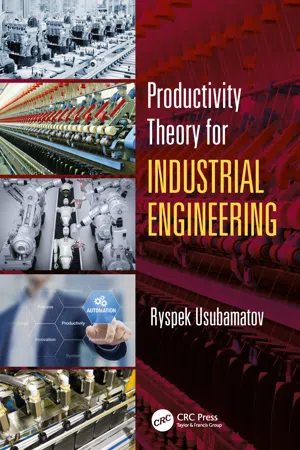Technology & Engineering
Industrial Engineering
Industrial Engineering is a branch of engineering that focuses on optimizing complex systems, processes, and organizations. It involves the application of mathematical and scientific principles to design, improve, and manage systems that involve people, materials, information, and energy. The goal is to increase efficiency, productivity, and quality while reducing waste, costs, and risks.
Written by Perlego with AI-assistance
Related key terms
2 Key excerpts on "Industrial Engineering"
- eBook - ePub
- Ryspek Usubamatov(Author)
- 2018(Publication Date)
- CRC Press(Publisher)
Different industries used different technologies, machinery and implemented different works. Hence, the mathematical models for productivity machines and systems for these industries will have specific parameters that reflect their particularities in technologies. If manufacturing and other similar industries are implementing repeatable work, it represents the machining or fabricating products at prescribed time, whereas in transport industries, there are fulfilled repeatable works to deliver objects to prescribed place and time by airplanes, trains, buses, cars, etc. Of course, other industries have their own specific properties of technological processes that should be included in mathematical models of the productivity rates. For example, the city bus motions from one bus stop to the other one represent the repeatable work of the bus traffic system that belongs to the transport industry. Mathematical models for productivity rate of the city bus system should be derived for its rush hours and regular one. Each industry has its own specific technologies and peculiarities. Nevertheless, it is easy to apply the productivity theory for Industrial Engineering for any type of industries and processes, i.e. for manufacturing, mining, transport, food, chemical, agricultural, etc. industries. This main property of productivity theory for Industrial Engineering expresses its universality, which can be automated with exact timing processes or manually controlled systems, where the timing components of production processes are calculated on statistically average data.Considering the processes of industries development in evolution, it is easy to trace that each historical step of engineering evolution is solving the problems of increase in the productivity rate and quality of products, services, etc. However, this evolutionary process of engineering linked with other problems. Increase in productivity rate of machinery leads to change in the numbers of employees, increasing the cost and complexity of engineering, etc. In our modern life, decrease of numbers of employees in real automated industries is not a problem, because there are many branches of economics with manual human activity that need mechanisation and automation to enhance productivity rate. History of engineering demonstrates that the moving force for engineering evolution is a constant requirement in sustainable improvement, increasing productivity rate and quality of products, services and efficiency of processes. These criteria are decisive for evaluation of progressiveness and perspectives of new engineering.2.2 Technological processes and balancing are the basis for structural designs of manufacturing machines and systems
Figure 2.1 Typical machine parts.In engineering, all mechanisms, machines and systems are assembled from the components, and machine parts with different designs can have simple and complex constructions (Figure 2.1 - Nigel F. Piercy(Author)
- 2018(Publication Date)
- Routledge(Publisher)
Chapter 2Information Technology in Engineering Production and Production Management
Denis R. TowillINTRODUCTION
Information technology (IT) is the modern name for the means by which we collect, store, process, and use information (Zorkoczy, 1982). Furthermore, it is not confined to hardware and software, but involves man in target setting and assessment criteria. It is built around the scientific, technological, engineering, and management disciplines used in information handling and processing, and at the present time is generally regarded as relating to computers and the interaction between man and machine. However, many of the basic ingredients needed within IT pre–date the microelectronic revolution. For many years effective management of manufacturing engineering has required the collection, generation, communication, recording, manipulation, and exploitation of information. A motivating factor in the new IT is the hope that the principles, practice, and terminology of information handling can be treated in a united, systematic way.Engineering production and production management are concerned with the effective use of people, products, plant and processes in modern manufacturing industry. This, in turn, is achieved by the proper selection and implementation of policies and plans. However, all six factors interact with each other, which partially explains the operational complexity which presently seems unavoidable. As we shall see, it is assisting the introduction of an integrated systems approach to problem solving in modern manufacturing industry which makes IT such a potentially powerful production management tool.The interaction problem can be best illustrated via the Venn diagram shown in Figure 2.1, in the type of display originated by Bestwick and Lockyer (1982). IT can help make each of the six cells independently more effective, but it is in the interactive zone where by far the biggest contribution may be expected. There are particular problems in the ‘people’ area, which are receiving exhaustive study under the heading of ‘dialogue engineering’ (Sime and Coombe, 1983).
Learn about this page
Index pages curate the most relevant extracts from our library of academic textbooks. They’ve been created using an in-house natural language model (NLM), each adding context and meaning to key research topics.

